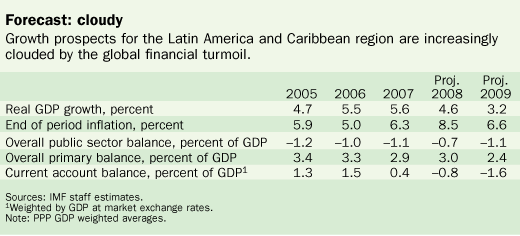
Typical street scene in Santa Ana, El Salvador. (Photo: iStock)
IMF Survey: Latin America, Caribbean Grapple With Global Crisis
October 27, 2008
- Regional growth expected to slow in face of global shocks
- First major test for region's strengthened policy frameworks
- Key task is maintaining confidence while mitigating expected slowdown
The outlook for the Latin America and Caribbean (LAC) region is increasingly clouded by the global financial turmoil and policymakers face tough choices, the IMF says in its latest regional economic outlook for the Western Hemisphere.

Export autos in Rio de Janeiro, Brazil: Latin America, Caribbean region's growth slowed by weaker external demand (photo: Antonio Scorza/AFP/Getty)
REGIONAL ECONOMIC OUTLOOK
The report, entitled "Grappling with the Global Financial Crisis", says the LAC region is coming off a remarkable growth spell with relatively low inflation. This has supported important gains on poverty reduction. Real growth has averaged about 5 percent since 2003, compared with the region's long-run average of about 3½ percent, supported in many countries by the commodity boom. Meanwhile balance sheets have been strengthened and substantial buffers of reserves created, with important credibility gains.
But the overall economic context, especially financing conditions, for the region have been tightening, despite the limited direct exposure of regional banks to troubled U.S. housing-related assets. In recent weeks equity markets have fallen dramatically, spreads on corporate bonds have risen sharply, and exchange rates have been volatile and in many cases have weakened sharply since September. Moreover, domestic financial markets in many countries are beginning to come under pressure while credit growth is slowing, says the outlook, released in Santiago, Chile, on October 22.
Significant growth slowdown
Growth was still strong in the LAC region during the first half of 2008. For the year as a whole, it is projected at 4.6 percent, before falling back sharply in 2009 to about 3 percent in the central scenario, although with appreciable downside risks (see chart).

The slowdown reflects three main factors:
• Tighter global financial conditions are expected to persist for some time, though the central scenario in the World Economic Outlook (WEO) assumes that the recent policy steps taken in the industrialized countries will gradually normalize markets.
• Commodity prices have fallen sharply and volatility has increased substantially, highlighting risks ahead. Oil products have experienced the largest declines, and prices have also dropped for many of the region's food exports—including soy products, corn, and coffee, which are important in countries such as Argentina, Brazil, and Colombia.
• External demand is sharply weakening. The United States, Europe, and Japan—which together account for about 70 percent of the region's exports—are set to slow sharply over the next year. This trend not only helps lower commodity prices but also slows remittances from and trade with the United States, which affects Mexico and Central America the most. Further, many countries, especially in the Caribbean, are being affected by a reduced demand for tourism services from both the United States and Europe.
Inflation expected to fall
The strong growth observed during the first half of 2008, combined with supply shocks—including from commodity prices—pushed up inflation across the region to 8¾ percent year-on-year this past August. However, inflation is expected to decline to about 6 ½ percent by end-2009, as growth slows and the effects of tighter monetary policy in several countries take hold.
Fiscal policy has been supportive in a number of countries, although many countries still have a procyclical fiscal stance, with rapid real spending growth financed by buoyant commodity revenue.
Food prices need policy response
The pickup in food inflation puts at risk the gains on poverty reduction from the sustained reduction of inflation across the region through 2006. The rise in food prices since end-2006 may have lowered real consumption of poor urban households, all other factors being equal, by 16 percent in Nicaragua and 3 percent in Mexico in this period.
International experience has shown that targeted social assistance is the most cost-effective means to mitigate the impact on the poor of higher food and fuel prices. A key issue here is that many countries still lack effective social safety nets that adequately reach vulnerable households. Second-best options, such as subsidies or tariff reductions, may be needed in the near term, but should be periodically reassessed and removed as better instruments can be put in place.
Current account deficits to widen
The external current account balance is expected to swing from a moderate surplus in 2003-07 to a deficit of 1.6 percent of GDP in 2009, as export growth slows in response to falling external demand and weaker commodity prices. Within the region, the decline in commodity prices will bring down current account deficits in Central America and the Caribbean, while widening the current account deficit in South America and Mexico.
Policy challenges ahead
The shocks buffeting the global economy present the first major test for the region's strengthened policy frameworks. Against this background, the policymakers in the region are on high alert and face several essential priorities in the period ahead:
• Preserve the functioning of financial systems by preemptively addressing risks from liquidity and asset quality. Some countries have already taken steps in this regard.
• Monetary and exchange rate policies will need to stay focused on preserving the credibility of the monetary policy framework. Central banks will need to maintain an active communication with markets on policy challenges and measures, especially on the future course of inflation, to keep expectations well anchored. Flexible exchange rates in many countries will continue to act as a natural cushion, although some use of reserves may help avoid disorderly market conditions.
• Fiscal balances will likely come under stress at a time when there will be increased need to maintain a robust safety net for those low-income households that would be affected by the slowdown. This will require a much more targeted strategy for fiscal spending to ensure that essential needs can be met while containing any additional financing requirements.
Comments on this article should be sent to imfsurvey@imf.org







